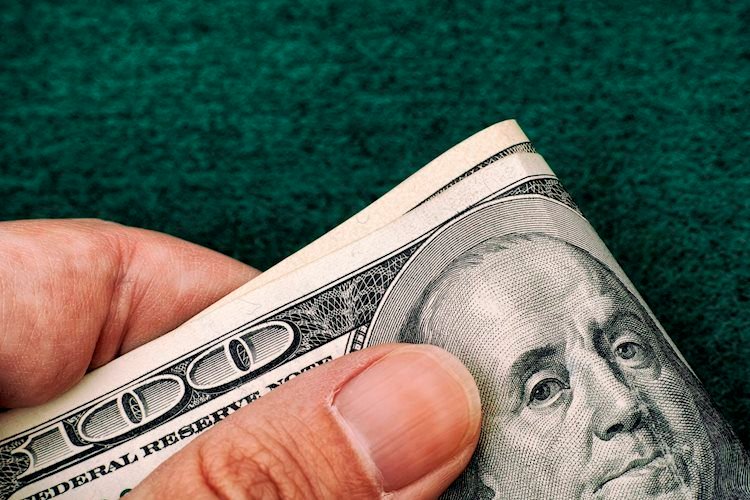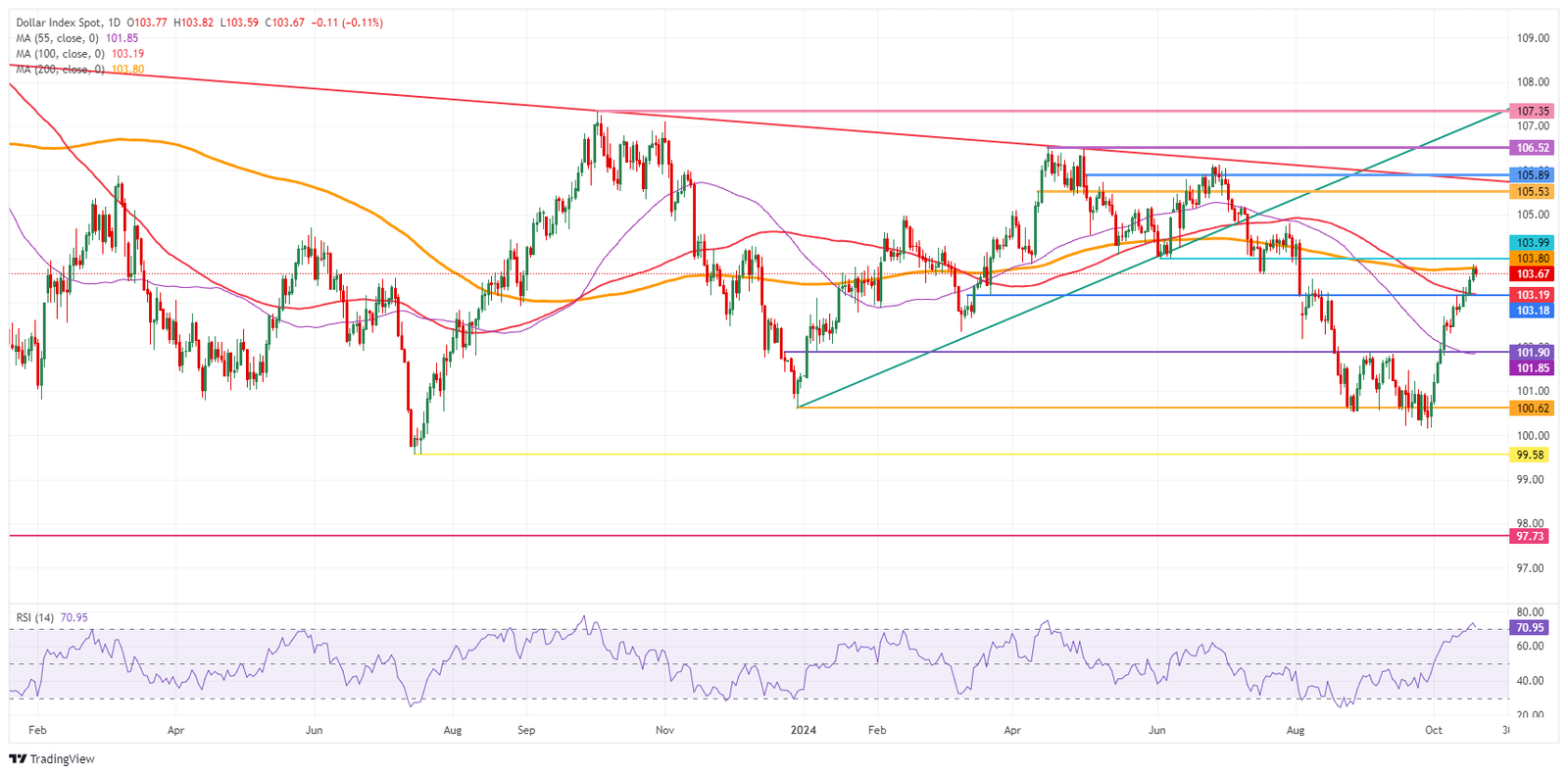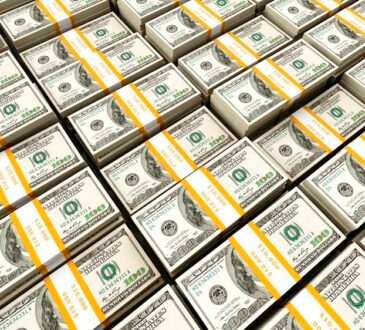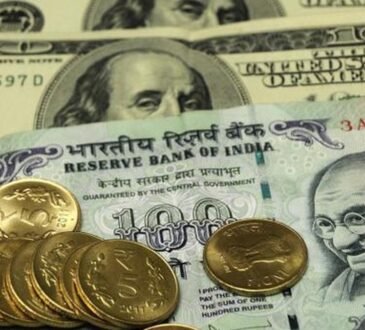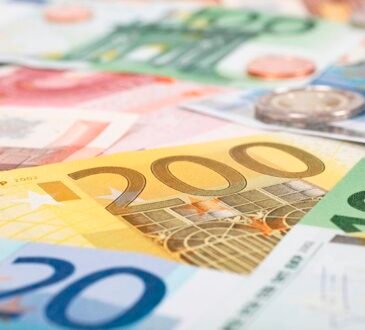- The US Dollar fades a touch on Friday after a steep ride higher.
- Traders see China stepping up measures with deposit rate cuts and more stimulus details.
- The US Dollar Index rally looks to be halting for now, ahead of 104.00.
The US Dollar (USD) turns flat to a touch softer on Friday with some profit-taking after steep rallies against many major G20 currencies this week. The slight retracement comes on the back of Chinese economic data and more details on the stimulus package the Chinese government is rolling out. With Chinese deposit rates being cut this Friday and more details released on the Chinese stimulus package, it looks like China is propping up its economy further.
The US calendar is very light in terms of economic data. No real market-moving data points will be issued on Friday, with only Building Permits and Housing Starts on deck. Instead, look for the Federal Reserve (Fed), where no less than three members are set to speak.
Daily digest market movers: Fed speak could fall on deaf ears
- At 12:30 GMT, the US Census Bureau will release housing data for September. Monthly Building Permits are expected to be at 1.46 million, compared to 1.47 million in August, while Housing Starts are expected to decrease to 1.35 million against 1.356 million prior.
- At 13:30 GMT, Federal Reserve Bank of Atlanta President Raphael Bostic delivers a presentation about economic education to high school students as part of the Mississippi Council on Economic Education Event.
- Around 14:00 GMT, Federal Reserve Bank of Minneapolis President Neel Kashkari moderates a policy panel at the 2024 Macroeconomic Policy Perspectives hosted by the Minneapolis Fed, the University of Chicago, and Stanford University.
- Near 16:10 GMT, Federal Reserve Governor Christopher Waller delivers a speech about decentralized finance at the Nineteenth Annual Vienna Macroeconomics Workshop in Vienna, Austria.
- At 16:30, Fed’s Bostic gives remarks and participates in a moderated conversation at the Mississippi Council on Economic Education’s Forum on American Enterprise luncheon, United States.
- Asian equities saw Chinese indices outperform on the extra wave of stimulus measures issued. European equities are trying to grasp European Central Bank President Christine Lagarde’s speech from Thursday on the sluggish European economy. US futures are flat on the day and are yet to choose a direction.
- The CME Fed rate expectation for the meeting on November 7 shows a 90.2% probability of a 25 bps rate cut, while the remaining 9.8% is pricing in no rate cut. Chances for a 50 bps rate cut have been fully priced out.
- The US 10-year benchmark rate is trading at 4.11% after having flirted with a break below 4% on Wednesday.
US Dollar Index Technical Analysis: First stop for now
The US Dollar Index (DXY) sees the rally train come to a halt, with some better-than-expected Chinese data and measures taken by the Chinese government to support domestic demand. Though this rally might face a small fade, a big reversal does not seem to be in the cards. With the interest rate gap between the US, the Euro and other currencies widening again, the Greenback should at least remain supported towards the US elections in November.
A firm resistance ahead is 103.80, which aligns with the 200-day SMA. Above that, there is a small gap before hitting the pivotal level at 103.99 and the 104.00 big figure. Should Trump further lead in the polls, a rapid swing up to 105.00 and 105.53 could be on the cards.
On the downside, the 100-day SMA at 103.19 and the pivotal level at 103.18 are now acting as support and should prevent the DXY from falling lower. With the Relative Strength Index in overbought territory, a test on this level looks granted. Further down, the 55-day SMA at 101.85 and the pivotal level at 101.90 should avoid further downside moves.
US Dollar Index: Daily Chart
US Dollar FAQs
The US Dollar (USD) is the official currency of the United States of America, and the ‘de facto’ currency of a significant number of other countries where it is found in circulation alongside local notes. It is the most heavily traded currency in the world, accounting for over 88% of all global foreign exchange turnover, or an average of $6.6 trillion in transactions per day, according to data from 2022. Following the second world war, the USD took over from the British Pound as the world’s reserve currency. For most of its history, the US Dollar was backed by Gold, until the Bretton Woods Agreement in 1971 when the Gold Standard went away.
The most important single factor impacting on the value of the US Dollar is monetary policy, which is shaped by the Federal Reserve (Fed). The Fed has two mandates: to achieve price stability (control inflation) and foster full employment. Its primary tool to achieve these two goals is by adjusting interest rates. When prices are rising too quickly and inflation is above the Fed’s 2% target, the Fed will raise rates, which helps the USD value. When inflation falls below 2% or the Unemployment Rate is too high, the Fed may lower interest rates, which weighs on the Greenback.
In extreme situations, the Federal Reserve can also print more Dollars and enact quantitative easing (QE). QE is the process by which the Fed substantially increases the flow of credit in a stuck financial system. It is a non-standard policy measure used when credit has dried up because banks will not lend to each other (out of the fear of counterparty default). It is a last resort when simply lowering interest rates is unlikely to achieve the necessary result. It was the Fed’s weapon of choice to combat the credit crunch that occurred during the Great Financial Crisis in 2008. It involves the Fed printing more Dollars and using them to buy US government bonds predominantly from financial institutions. QE usually leads to a weaker US Dollar.
Quantitative tightening (QT) is the reverse process whereby the Federal Reserve stops buying bonds from financial institutions and does not reinvest the principal from the bonds it holds maturing in new purchases. It is usually positive for the US Dollar.

